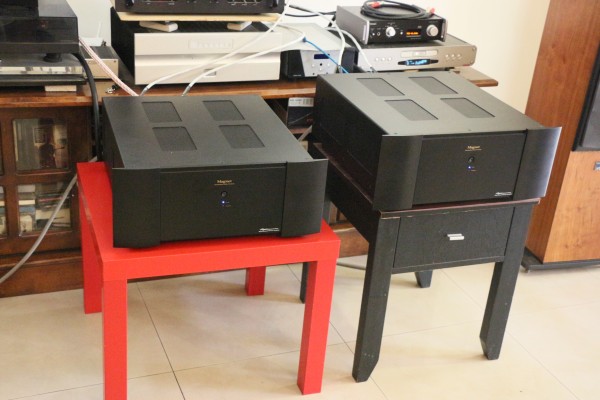
By Lam Seng Fatt
Since Victor Pheh of hifi creations liked what he heard in my house with one Magnet Hyperion Reference One stereo amplifier in the sound system, he returned the next day with another amp for me to try bi-amping.
I was thrilled to be given the opportunity to test three modes of playing that I had always wanted to check out. Normally, dealers would deliver just one amp for audition; so getting two from Victor was a welcome surprise.
I had always wanted to check out bi-amping – vertical vs horizontal. And I had also always wanted to check out the effects of bridging amps. My Bryston 4B SST can be bridged, but I have never been able to get another 4B SST to conduct all these tests.
I had to google around to make sure I got the right way to connect things up. For the benefit of readers, I shall describe in detail the right way to plug the interconnects and speaker cables.
BTW, the way I did the bi-amping is technically called passive bi-amping as I am using the crossover networks of the speakers to split the frequencies to the individual speaker units. For active bi-amping (or tri-amping) just go and listen to the active ATC speakers at Hi-Way Laser or the active PMCs at AV Designs.
For passive bi-amping, you need a preamp with two sets of analogue outputs. If not, you would need a Y-splitter. Thankfully, my Lamm LL2 Deluxe preamp has two sets of outputs.
Plus your speakers must be bi-wireable i.e. they must have two pairs of speaker terminals. My ATC SCM40s actually have three pairs of speaker terminals each. My only problem was not having enough cables, but more on that later.
Passive horizontal bi-amping: How to…
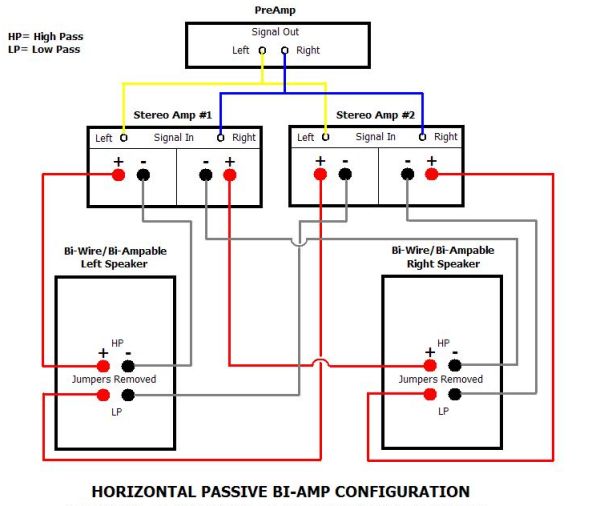
1) Connect a pair of interconnects (+ and -) from preamp to one stereo power amp (+ and -).
2) Connect a pair of speaker cables to the bass terminals of the left and right speaker. The jumpers linking the bass terminals to the tweeter terminals must be removed.
3) Connect the second pair of interconnects (+ and -) from preamp to the second stereo power amp (+ and -).
4) Connect a second pair of speaker cables to the tweeter terminals of the left and right speaker.
Passive horizontal bi-amping results in one stereo amp driving only the woofers and the second stereo amp driving only the tweeters of the speakers.
Passive vertical bi-amping: How to…
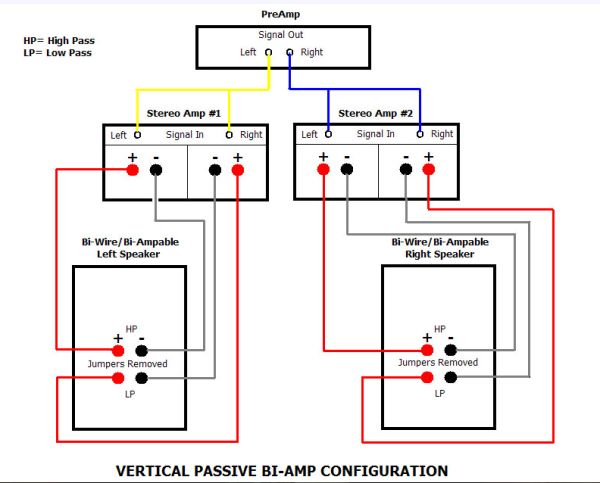
1) Connect two interconnects (+ [red] and + [red]) from preamp to one stereo amp (+ and -).
2) Connect speaker cables from one channel to the woofer terminals of the right speaker.
3) Connect speaker cables from the other channel to the tweeter terminals of the right speaker.
4) Connect two interconnects (- [black] and – [black]) from preamp to the other stereo amp (+ and -).
5) Connect speaker cables from one channel to the woofer terminals of the left speaker.
6) Connect speaker cables from the other channel to the tweeter terminals of the left speaker.
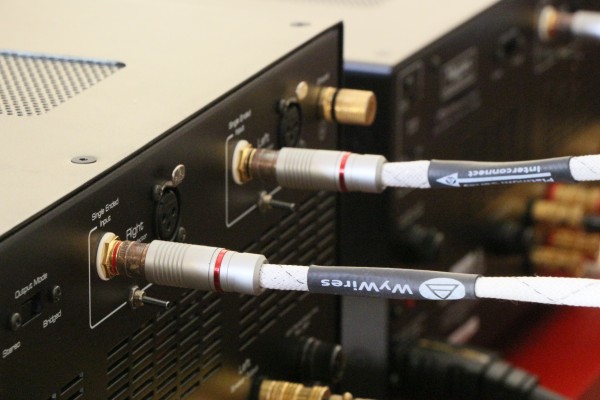
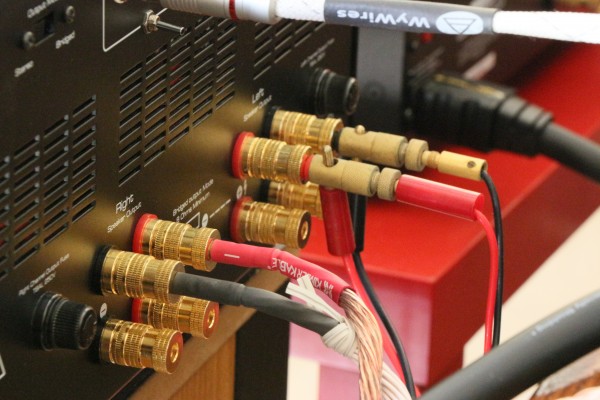
Passive vertical bi-amping results in one stereo amp driving the woofer and tweeter of the left speaker and the other stereo amp driving the woofer and tweeter of the right speaker.
It is advisable to use two similar amps for bi-amping as they would have the same gain and sonic signatures. It is also advisable to use the same power cords, interconnects and speaker cables to link up both amps.
There are some people who prefer passive horizontal bi-amping as they can use a tube amp for the mids and highs and a solid-state amp for the bass. There are also people who advise against that.
Though I did not try the mix-and-match way to get a tube amp to work with a solid-state amp, the problems I encountered trying to get the system to sound right with different cables suggested that it is best to use the same amps and same cables throughout. I changed just one power cord and the sound was thrown off balance.
I use Kimber 12TC speaker cables in my system and I did not have a second pair. I rummaged around and found a pair of Canare speaker cables. I used them for the tweeters and then for the woofers with the Kimber and could not get the system to sound right. In the end, I found a pair of single bi-wire DH Labs Q-10 speaker cables and used them for the mids and highs and the Kimber for the bass. Finally, I got the sound to be acceptable.
As for the interconnects, I had used my two pairs of WyWires Platinum to connect the preamp to the two stereo amps and I found an old pair of Blue Jean interconnects. This turned out to be problematic as they did not match the sound of the system. In the end, I dug up a pair of DH Labs Air Matrix interconnects and these managed to fit in with the sonic signature that I was aiming for.
I would have preferred to use all WyWires interconnects and all Kimber 12TC speaker cables, but the system as it was finally set up sounded quite tonally balanced. As for power cords, I used those that came with the Magnet amps.
Passive horizontal bi-amping: How did it sound?
Everything was super-sized – the vocalist, musicians, musical instruments, sound stage, bass drums, bass guitar, the whole works. Everything was bigger and it was as if I was seated in the front row of the concert hall.
There were lots of details that popped up from the music. I could hear lots more ambience such as the acoustics of the concert hall especially in live recordings. The bass had great impact and kick.
It was a front-row experience with huge images and soundstage.
Passive vertical bi-amping: How did it sound?
Everything was bigger, but not super-sized. The images and soundstage were larger than when just one stereo amp was used, but they were not unnaturally large as they seemed to be when the system was horizontally bi-amped.
I could still hear the tiny details that popped up from the music, but the more exciting facet was the ‘layering’ of images.
The soundstage became more 3-D with enormous depth and I could make out the musicians located in their own space on different parts of the stage – especially on good live recordings.
There was one song by Salena Jones which had brushstrokes on a cymbal which actually imaged in front of the left speaker. The brushstrokes were thrust out in front of the speaker and there was so much detail that I actually wondered if I was hearing something from outside the house and I actualy walked towards the speaker to confirm that the sound was indeed that of brushstrokes from the tweeter. It was that amazing.
The bass drums also had impact and kick, and at last I was satisfied with the sound of the double-bass which had the right ‘thump’, resonance and body. There is a track in last year’s Kuala Lumpur International AV Show commemorative CD that features Christian Mcbride playing his double bass with Gena playing a Jew’s harp called Chitlins & Gefiltefis which never really had me satisfied till when I played it in this vertically bi-amped system which made the double bass sound full, resonant and realistic.
Once more, I had a front-row listening experience and I could hear little details and the ambience of the venue. Another plus point was that I could hear details even on low-level listening. Usually there is certain level when you turn down the volume that details go missing and you find yourself having to turn the volume up a bit to hear better-quality sound. Not so with vertical bi-amping.
Verdict
Once you have listened to a sound system that is passively vertically bi-amped, there is no turning back.
My dilemma now is how to find the funds to buy another Bryston 4B SST and allocate space for it. Plus, I also have to figure out how to get the cash for another pair of WyWires Platinum and Kimber 12TC speaker cables. Sigh…..If you are broke, do not try passive vertical bi-amping. You have been warned!

hi paul,
nice to know that you have made the right decision.
enjoy….
tq
sflam
Hi Lam! I have been deciding between horizontal and vertical passive bi-amping for a few months now. After reading this article, I had made my decision: I’ve just purchased the second identical amplifier [2 x 65 W @ 8 Ω] and went for the vertical bi-amping. I am now pumping 130 Watts into the left speaker and 130 Watts into the right speaker. However, with me, it’s not only about the power, it’s mostly about the high resolution audio. The result is absolutely stunning. I tried playing one of my SACDs and I could immediately hear the difference in stereo clarity and overall sound definition. Even when I play the 320 Kbps MP3 background Internet music radio, I can hear the difference. I don’t understand why there is so much negative stuff about passive bi-amping on the Internet. Virtually all articles on the Internet are against passive bi-amping and recommend implementation of active electronic crossovers. Well, I am not stupid enough to start disassembling my Wharfedale Diamond 200 Series speakers just to implement some idiotic active crossover. I am absolutely satisfied with the “factory-provided” passive network inside my speakers. Thanks for the article. Paul
hi bogdan,
no i have not.
Have you tried since a comparison between passive vertical and active horizontal?
Your experiment with vertical passive should yield better results, because of greater stereo separation of the power supplies. ie, left channel signal not leaking to right channel. Much like using mono blocks.